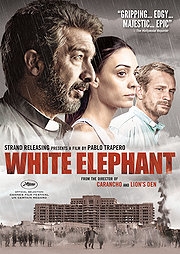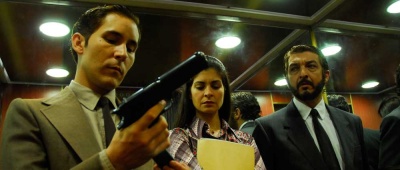Carancho

Carancho opens with a series of black and white photos of a car crash – shattered glass, tangled metal, a lifeless arm – instantly setting the tone for this film. It’s a pacy, sharp-edged drama with elements of a thriller, focussing on the horrifying ubiquity of traffic accidents in modern day Buenos Aires (there are over 8000 deaths in Argentina every year) and the lives of those people who are there to clean up – or in some cases, profit from – the mess. The film’s interesting premise is propped up by taut direction and excellent, powerful performances from its leads, but Carancho is let down by an ending that smacks of a lazy Hollywood thriller.

Sosa (Darín) is a carancho (in English, “vulture”) – an ambulance chasing personal injury lawyer working for a shady firm that swindles money from victims of traffic accidents. Into Sosa’s life arrives a paramedic – Luján (Gusmán) – and the two quickly become romantically involved, with Luján pushing him away when she learns of his dodgy dealings (including actually staging traffic accidents). But this film is by no means a simplistic drama teaching the redemptive power of love. Sosa and Luján’s relationship is complicated from the off – indeed, we first meet Luján injecting drugs into her trackmarked foot just before she begins work on a shift. Luján’s hollow-cheeked, mournful face and unexplained scarring speak of a life of hardship and loneliness, whilst Sosa comes across as a man who is keen to do the right thing, but finds himself inevitably dragged back into crime.

Trapero’s direction is skilful in depicting the world in which Luján and Sosa must struggle to survive. Luján’s hospital and Sosa’s cramped office are dingy and worn out – much like the protagonists themselves – and the ever-lingering soundtrack of nearby traffic serves to remind the characters and audience alike that always, just on the periphery, some terrible disaster is about to take place. Particularly convincing are the scenes taking place in the hospital, which Luján and the other doctors navigate with an air of unshockable weariness. A consummate professional with her patients, Luján has nonetheless become desensitised to the pain and suffering she bears witness to every day. Indeed, it appears the only two things that can stir some real feeling in her are the drugs to which she is addicted, and the romantic affections of father figure Sosa.
Having established, however, an interesting premise and well-rounded, intriguing characters, Trapero seems to lose his grip on what he is trying to achieve half way through his film. When Luján discovers what Sosa has been doing, she breaks contact with him. There is then a somewhat clunky jump forward in time and Sosa returns to Luján, having shaved his head and attempting to set his life back on track by legitimately helping the victims of accidents. The story then follows the two becoming embroiled in a feud with Sosa’s ex bosses, requiring both to act in increasingly unrealistic ways in order to push forward the plot.

In the last twenty minutes the film hurtles – almost like a careening car, if we’re going to get deep here – towards a swift, dissatisfying conclusion. Ultimately, Trapero betrays his characters by removing their autonomy and transforming them into objects moved along by currents they can’t control. It may be a comment on the futility of attempting to live for yourself in a world which seeks to drag you down, but the ending to Carancho feels less like a piece of social commentary than a sleekly filmed, somewhat empty final flourish designed to shock, in the vein of the most cynical Hollywood blockbusters.




Recent Comments